The first tour of 2017, and it was down to the Norfolk Broads today. It was a misty start and, contrary to the forecast, the mist never really lifted completely all day. But it was clear enough, pretty much dry throughout, not too cold – not a bad day to be out and about.
Our first stop was at Ludham. As we pulled up alongside the field which the swans have been favouring, the first thing we saw was a load of Egyptian Geese right beside the road, about 60 of them. Quite a sight!
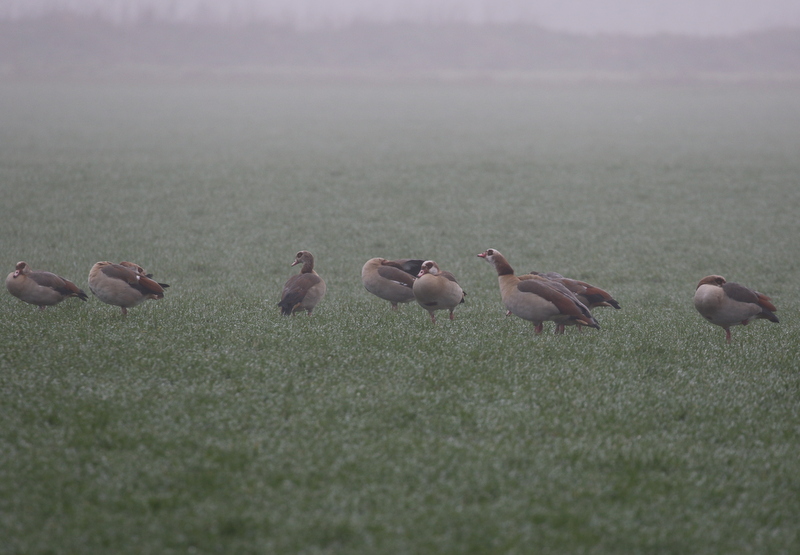 Egyptian Geese – a few of the 60 that were in the fields at Ludham today
Egyptian Geese – a few of the 60 that were in the fields at Ludham today
Through the mist, we could make out lots and lots of white shapes and through binoculars we could see they were the swans. Out of the car, we got them in the scope, fortuitously straight onto a view with a Bewick’s Swan and a Whooper Swan side by side in the foreground! One of the nice things about this herd of swans is that it is generally mixed, giving a great opportunity to compare the two species side by side. We could see the Whooper was noticeably larger and longer necked that the Bewick’s Swan and yellow on the bill of the Whooper Swan extends down towards the tip in a pointed wedge.
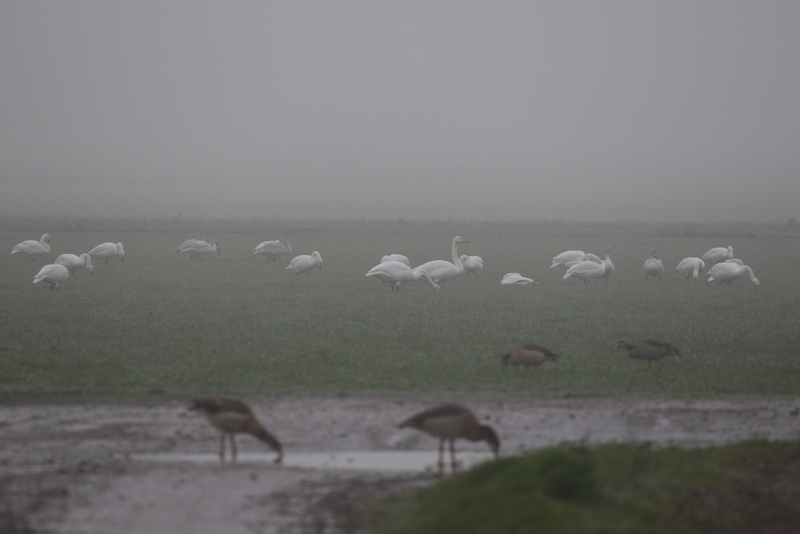 Whooper & Bewick’s Swans – in the mist this morning
Whooper & Bewick’s Swans – in the mist this morning
A quick count revealed there were 123 swans of which 23 were Whooper Swans and 100 Bewick’s Swans. Numbers of Whoopers have been pretty static since the turn of the year, but the number of Bewick’s here has increased, perhaps with birds moving in from the continent in response to colder weather over there.
Across the other side of the road, a field of sugar beet had recently been harvested and loaded onto lorries to be taken away – although several large beet and a significant quantity of accompanying mud had been deposited into the road! A single Egyptian Goose was feeding on the beet tops which had been left behind out in the field and, after a quick scan, we found two more geese in the field over at the back. Through the scope, we could just make out their orange legs and orange-banded dark bill – they were Tundra Bean Geese. There are two subspecies of Bean Goose which regularly winter in the UK – Tundra and Taiga Bean Goose. A variable number of Tundra Bean Geese come over each winter and are more often found in with the large flocks of Pink-footed Geese.
Having taken our fill of the swans, we set off again and made our way south. On the way, we came across a huge flock of geese in another large recently cut sugar beet field by the side of the road. Unfortunately, there was nowhere to stop and lots of traffic but we marveled at them as we drove past. Most of the flock was comprised of thousands of Pink-footed Geese. We could also make out three swans with them, more Whooper Swans. Quite a sight!
We had hoped to pick up a few Cranes in the fields on our travels, but it was still too misty to see far from the roads. We decided to head for Halvergate. There have been four Cattle Egrets here since before Christmas, which we hoped to catch up with. There was no sign of them at first. We could see several cows out on the grazing marshes, so we walked along the road to where we could get a better view to see if anything was with them.
One of the group noticed something swimming in the ditch next to the road, but it disappeared into the near bank. Then something else appeared on the far bank, a Weasel. We walked up to where it had been and there was no sign of it at first. But then suddenly it appeared again out of the grass and ran out across a wooden cattle bridge. We had great views of it as it ran in and out of the wooden sleepers on the bridge, then ran back along the far bank of the ditch, looking for something to eat.
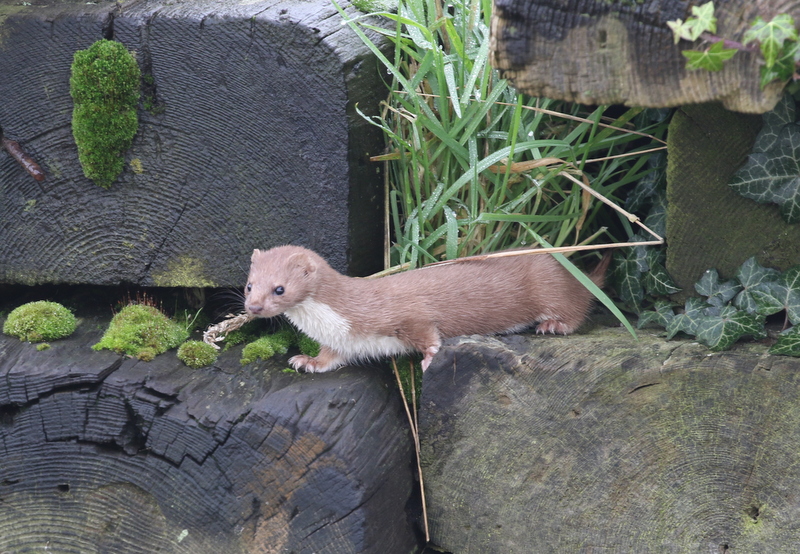 Weasel – ran up and down the river bank in front of us
Weasel – ran up and down the river bank in front of us
A white shape appeared out of the rushes on the bank of one of the ditches further back and flew out to join the cows, landing in among their feet. It was one of the Cattle Egret. It was darting in and out of the cows’ legs, and the cattle helpfully then walked out of the rushes and onto the shorter grass, bringing the Cattle Egret with them. We got a great look at it through the scope.
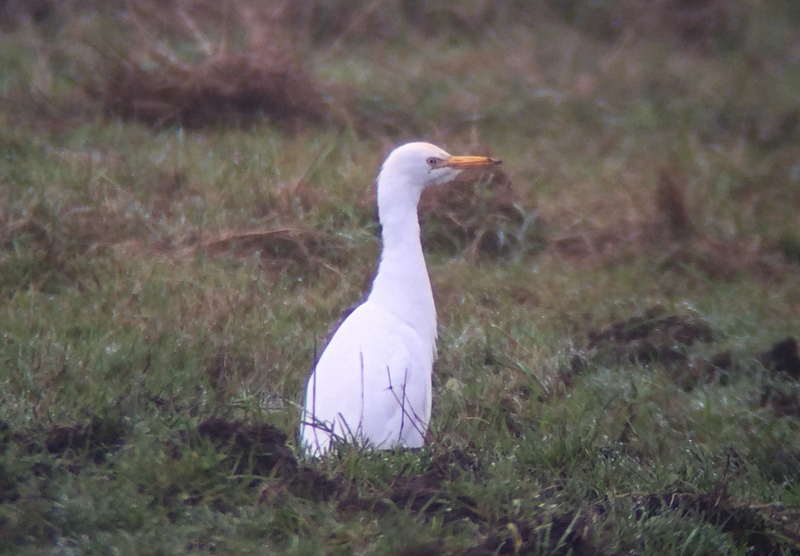 Cattle Egret – 1 of the 4 birds at Halvergate showed very well
Cattle Egret – 1 of the 4 birds at Halvergate showed very well
Cattle Egret is a species which has been spreading north out of its historic core range in Spain and Portugal. It has yet to properly colonise the UK, like the Little Egret has done, although it did breed in Somerset in 2008. It is prone to irruptions and this winter a large number have arrived into the UK again. Hopefully, some might stay to breed again in this country again in 2017!
While we were watching the Cattle Egret, there were a few other birds around the marshes here. A Grey Heron was showing well in the same field as the cows, and a pair of Stonechats was feeding in among the cattle too, perching up on the taller dead thistles between dropping down to the ground after insects churned up in the mud.
Visibility improved while we were at Halvergate and, driving round to Cantley next, the sun appeared finally to be breaking through. Could it burn off the mist? Unfortunately it was short-lived, and by the time we got to Cantley Marshes the mist had descended again. There were no geese immediately visible directly in front of the gate, where they have been feeding recently. However, we could see quite a number of Marsh Harriers all standing out in the grass. There were at least five of them and they kept flying round from time to time before landing again. When one of them landed closer, we could see it was carrying green wing tags and through the scope we could see it had the code ‘VC’. Checking later, we found that it had been tagged as a nestling at Hardley in the Norfolk Broads in July 2016, so she hadn’t ventured too far afield.
Scanning further round, we could see lots of Pink-footed Geese out to the left of us. We could see their dark heads and necks and small, dark bills with a variable pink band. One of them was carrying a grey neck collar with the code ‘N29’. Checking online later, we could see that this goose was ringed in Denmark in March 2009. It was seen in Denmark again in September-December 2009, before moving over to Buckenham Marshes in Norfolk in January 2010.In subsequent winters, it has been seen in Lancashire, Scotland and even the Netherlands, but has also regularly been seen in Norfolk and particularly at Buckenham and Cantley. Interesting stuff, showing the benefit of colour marking birds in tracking their subsequent movements.
Eventually we found the White-fronted Geese too, out to the right, along the railway line. There was still quite a bit of mist and they were rather distant, which made them harder to see. We could just see their white fronts when they lifted their heads – the white surround to the base of the adults’ bills. There were also two Ruff out in the grass, one of which was sporting a rather striking pure white head which made it easier to see (the males are rather variable in winter, much as they are in breeding plumage). However, we couldn’t see any sign of any Taiga Bean Geese here today.
When several birds started alarm calling behind us, we turned to see a young Peregrine disappearing off over the houses. A couple of seconds later, it flew back towards us and off along the railway towards Buckenham. The next time we herd the birds getting upset, we turned to see an adult Peregrine flying low across the grazing marshes. It flushed a Common Snipe and chased it half-heartedly. Then a second adult Peregrine flew in behind it, and had a quick go at a passing Lapwing. Both adult Peregrines then flew across the grass and landed on a gate, where we could see them perched distantly, clearly the resident local pair.
We made our way round to Buckenham Marshes next, just a short distance as the Peregrine or Pink-footed Goose flies, but a rather more circuitous drive. We walked out over the railway again and down the rough track across the marshes. There is a particular area of the marshes which is favoured by the Taiga Bean Geese when they are here, and a quick glance across revealed a small party of geese in the distance. Through the scope and through the mist we could just make out that they were indeed the Taiga Bean Geese, but they didn’t help matters by disappearing into some taller vegetation.
Thinking we would have another look for them on the way back, we carried on down the track. There were some nice groups of Wigeon feeding on the grass close to the path, giving us a great opportunity to get a close look at them. The drakes are looking especially smart now, with their rusty brown heads and creamy yellow foreheads, looking like someone has attacked them with a paintbrush.
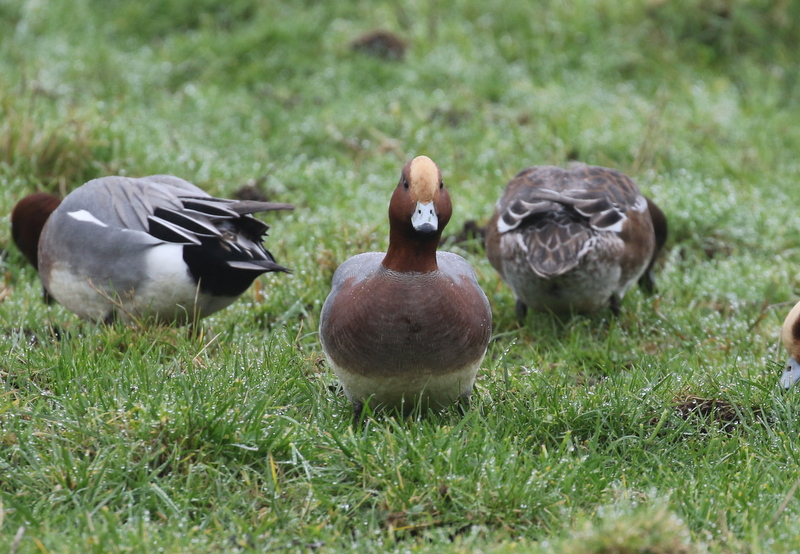 Wigeon – a drake showing the creamy yellow stripe up its forehead
Wigeon – a drake showing the creamy yellow stripe up its forehead
A smart Common Snipe posed nicely for us next to one of the small wet pools out in the grass. Several Meadow Pipits flew back and forth across the track and one settled briefly on the mud for us to look at it. A couple of Little Egrets chased each other up and down one of the ditches. A single adult Peregrine was preening on one of the many wooden gates out on the marshes, and this one was much closer than the pair we had seen earlier at Cantley, giving us a great view of it through the scope.
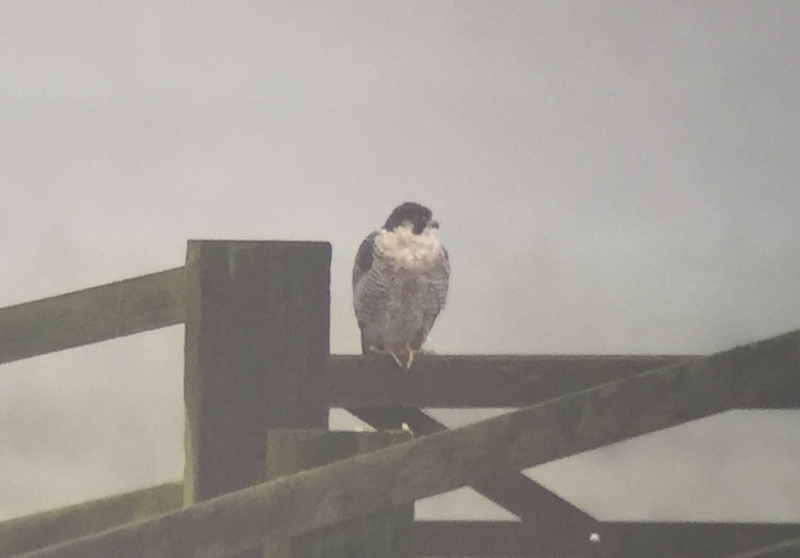 Peregrine – this adult posed nicely for us at Buckenham
Peregrine – this adult posed nicely for us at Buckenham
Up towards the river bank, the pools held a few more ducks. Among the many Teal, we managed to find a few Shoveler. On one of the small islands, two small waders were running around in among the Teal, a couple of Dunlin. There were lots of Lapwing around the marshes too.
Walking back towards the railway crossing, we could not see any sign of the Taiga Bean Geese. However, we could get rather closer to where we had earlier seen them by walking down the railway platform. When we got to the end, there they were out on the grazing marsh, around 20 Taiga Bean Geese. We had a much better view of them from here, despite the lingering mist. We could see the more extensive orange on their bills compared to the Tundra Bean Geese we had seen earlier this morning. A very small number of Taiga Bean Geese winter regularly in the UK, from the declining breeding population in Sweden, but they are very faithful to only two sites, one group here in Norfolk and one at Slamannan in Scotland.
 Taiga Bean Geese – about 20 were at Buckenham today
Taiga Bean Geese – about 20 were at Buckenham today
It was getting on for lunchtime, so we headed round to Strumpshaw Fen. We ate our lunch overlooking the pool in front of reception hide. There was a good number of Gadwall and Coot out on the water, plus a few Shoveler and a single Cormorant drying its wings on a post. More Cormorants were standing in the dead trees in the distance, over towards the river, and four or five Marsh Harriers circled over the reeds.
The resident escaped Black Swan was also standing on the edge of the pool, a reminder of home for the Australian contingent in the group today! A Cetti’s Warbler sang briefly and was then to be heard calling in the reeds. More obliging was the very smart Kingfisher which perched on a curved reed stem out in full view in front of us.
 Kingfisher – posed very nicely for us at Strumpshaw Fen over lunch
Kingfisher – posed very nicely for us at Strumpshaw Fen over lunch
Once we had finished eating, we turned our attention to the feeders behind us. There were lots of Blue Tits and Great Tits coming in and out all the time. It didn’t take long before our attention was rewarded with a single Marsh Tit. Several times it darted in, grabbed a seed and disappeared back into the trees behind to eat it, before flying across to the woods beyond.
We drove round via Ranworth next, and had a quick look at Malthouse Broad. On a tour to the Broads, it is always nice to see a proper broad! On the lawn on the edge of the moorings, a tame Pink-footed Goose was feeding with three Greylag Geese. It was an odd place to see one, but great to see it up front and in close comparison with the Greylags. The Pink-footed Goose appeared to have an injured wing, which would probably explain why it was here.
 Pink-footed Goose – this apparently injured bird was feeding with the local Greylags
Pink-footed Goose – this apparently injured bird was feeding with the local Greylags
There were lots of Tufted Ducks and Coot out on the water. A single Little Grebe was hiding at the back of the broad, under the overhanging trees. Unfortunately there was no sign of the Ferruginous Duck which had been here for a couple of days, though by all accounts it was very tame so was best described as of ‘uncertain origin’!!
At this point the mist appeared to start rolling in again, so we decided to head back to look for Cranes in case visibility deteriorated much further again. At our first stop, we could only see a lone Grey Heron initially. Then we noticed two large, pale grey shapes in the distance. Through scope, we could just see they were two Cranes, walking about half obscured behind the reeds. It was hard for everyone to get onto them, given the combination of vegetation and mist. We figured we might be able to see them better from further along road.
 Crane – one of a pair we found in the fields today
Crane – one of a pair we found in the fields today
After a short drive, we managed to pull off the road and got out. The Cranes were much easier to see from here and the whole group got good views of them through the scope. Such huge and majestic birds, it is great to see them wild in the Norfolk countryside. After watching them feeding happily for some time, they suddenly took off and circled round, their long necks held out in front and long trailing legs behind, before dropping back down behind some trees out of view. Great stuff!
It was then time to head back to Hickling for the last of the afternoon’s activities. As we walked out past Stubb Mill, a single Goldcrest was flicking around in the bushes.
From the watchpoint, one of the resident pair of Cranes was visible on arrival, standing behind the reeds. We watched it walking up and down, before it disappeared from view behind the vegetation. Sometime later, it appeared again with its partner in tow.
There were lots of finches around the mill bushes – Chaffinches, Linnets, a Greenfinch. While we were standing watching the comings and goings over the marshes a small flock of Bramblings flew in. Most of them dropped down to the path below, presumably to drink, but one perched up nicely for us in the top of one of the bushes. Through the scope, we could see its bright orange shoulders. A flock of Fieldfares also perched up in the trees just behind. An extended family of Long-tailed Tits appeared in the trees from our left and made their way back and forth through the bushes right in front of the watchpoint.
A steady trickle of harriers flew in to roost. Most of them were Marsh Harriers, at least 30 today. They flew in from all directions, and several of them perched up in the bushes in the reeds. We also saw two male Hen Harriers, both smart grey males, though they were a little distant this evening. They both came in from the south and flew steadily in over the reeds towards the gathering of Marsh Harriers. A Merlin was more obliging, and perched up in the bushes on the near edge of the reeds so we could get it in the scope. We had hoped for more Cranes to fly in at dusk, but the mist descended and visibility deteriorated again.
We had seen all we wanted to see, so we decided to call it a night. A Tawny Owl hooted briefly from the bushes by the mill and, on the walk back, we could hear a second Tawny Owl calling and a third hooting back in the car park. A nice way to end a very enjoyable – and successful – winter’s day in the Broads.
















